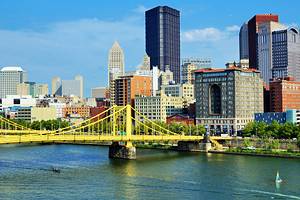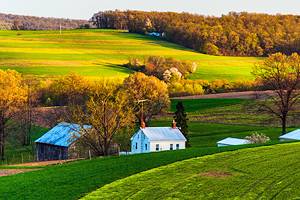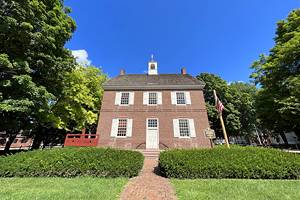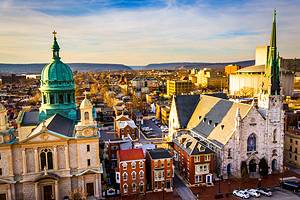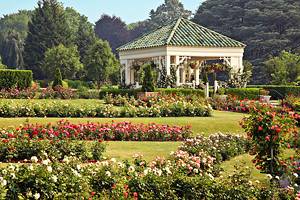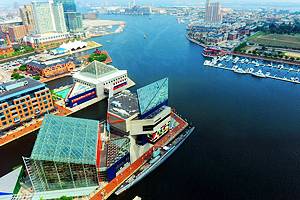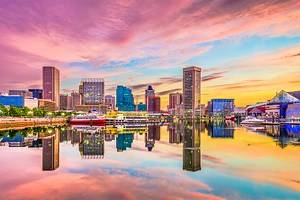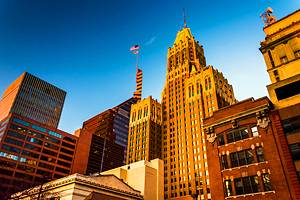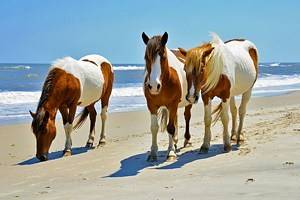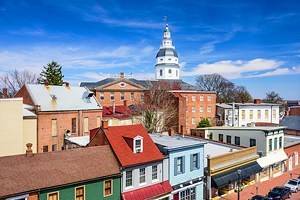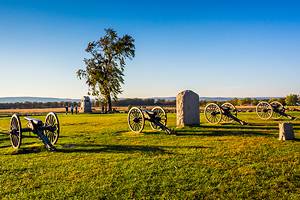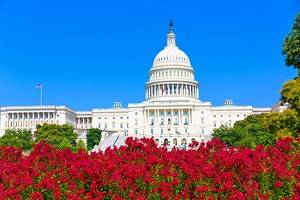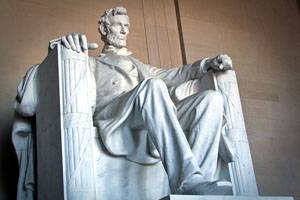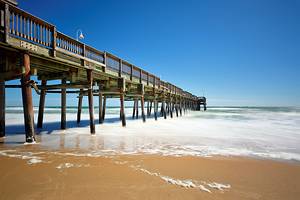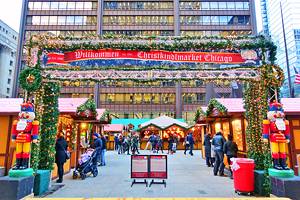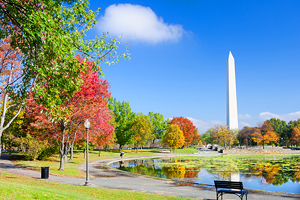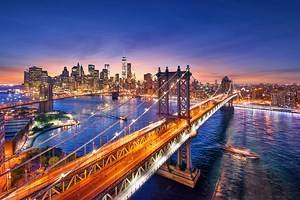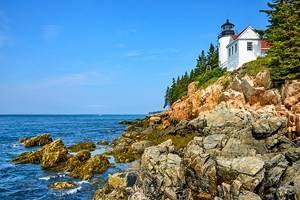Attractions & Things to Do in Gettysburg
Gettysburg is famous for the three-day Civil War battle that is considered the turning point in the Civil War, and it remains one of the most popular places to visit in Pennsylvania because of its historic significance.
Among the many things to do within Gettysburg National Military Park are visiting its museums, touring the battlefields, watching battle re-enactments, and exploring the "Summer White House" of President Dwight D. Eisenhower.
Gettysburg's small-town charm is undeniable no matter what your interests. It offers cozy historic inns, lovely parks, and even local shops among the many monuments and historic sites. It's a popular day trip destination from Philadelphia, as well as from Washington, D.C., and is often part of an American history tour for families.
Although a battlefield might not seem like a place to visit with kids while you're on vacation, several of the attractions are designed to engage children and teens. And, a trip to Gettysburg can be an economical one for a family: along with Battlefield Park, the historic Rupp House and the Gettysburg Museum of History are among the free things to do in Gettysburg.
The best time to visit is spring or fall, when the weather is mild enough to enjoy walking outdoors, but without the summer vacation crowds.
For sightseeing ideas, see our list of the top attractions and things to do in Gettysburg.
- Visit the Battlefield and Monuments
- Take a Battlefield Tour
- Stop at the Museum and Visitor Center
- Soldiers' National Cemetery
- Little Round Top
- See the Gettysburg Civil War Reenactment
- Eisenhower National Historic Site
- Shriver House Museum
- Jennie Wade House
- David Wills House
- Gettysburg Museum of History
- Sachs Covered Bridge
- Bicycling Through the Battlefield
- Map of Attractions & Things to Do in Gettysburg
Visit the Battlefield and Monuments
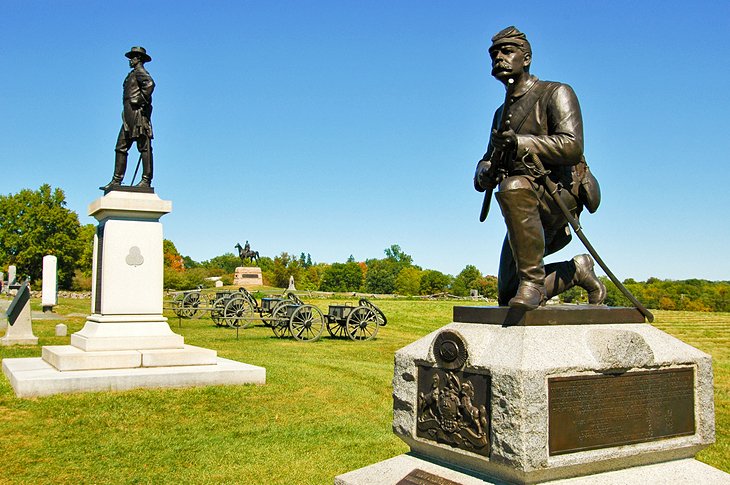
Nearly 1,400 monuments and statues are placed across the huge battlefield at Gettysburg National Military Park, making it one of the largest collections of outdoor sculpture in the world. Most of these monuments stand where the particular units fought, with small square stones indicating the lines of the unit's formation.
While today's monuments commemorate both armies, at the beginning, Union veterans objected to any recognizing of the South. It was not until 1886 that the bitterness of the war had subsided enough for Confederate memorials to be accepted, and the first was erected at Culp's Hill commemorating the 2nd Maryland Infantry.
Highlights among the monuments mark the prominent positions and battles at Seminary Ridge, Cemetery Ridge, and Oak Ridge. On Seminary Ridge, the primary Confederate position on the west, one of the most prominent is the North Carolina Memorial, depicting five soldiers advancing in Pickett's Charge.
Atop the ridge stands the Virginia State Memorial, with a young bugler and color bearer surrounded by five fellow soldiers. Above them, as though still commanding the ridge, is General Robert E. Lee on his horse Traveler, cast in bronze by Louis Tiffany & Sons.
Facing them on Cemetery Ridge, held by the Union lines for the final two days of battle, is the Pennsylvania Memorial, the largest and most complex of the park's monuments and the only memorial recording the names of all the soldiers from the state who fought here, engraved on 90 bronze tablets at its base.
On Oak Ridge, the site of the opening day's battle before the Union army fell back to Cemetery Hill, is the Eternal Light Peace Memorial. It was dedicated in 1938 by more than 1,800 Civil War veterans of both armies to "Peace Eternal in a Nation United" on the 75th anniversary of the battle.
Take a Battlefield Tour
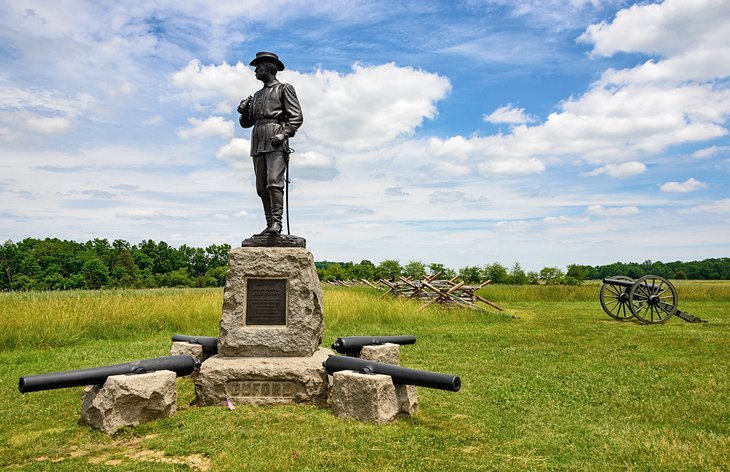
The best way to see the battlefield and understand what happened here is to take a tour with a licensed battlefield guide. One option is to take a tour in your own car with a battlefield guide who can explain the site's history as you explore the parts that interest you most.
You can also follow a self-guided driving or walking tour of the battlefield using an audio tour or the detailed guide book from the museum shop. A full walking tour will take about four hours. Or you can take one of the park's Ranger Programs, which include daily walks, tours, and hikes; if you're visiting with kids, be sure to check out the Junior Ranger programs.
Stop at the Museum and Visitor Center

The best place to begin is at the visitor center and its museum for an overview that puts the battle and this war in context. Here, you'll learn more about what caused the Civil War and how Gettysburg was that conflict's most decisive moment, as heavy casualties crippled the Confederacy and turned the course of the war in favor of the North.
A highlight of the museum is the Battle of Gettysburg Cyclorama, painted in the late 1880s by the French artist Paul Philippoteaux. This dramatic painting is enhanced by audio and visual effects that put visitors in the center of the fury of Pickett's Charge, on the third day of the battle.
In the museum's 11 galleries, you'll see artifacts and displays about the battle, the war, and its aftermath, as well as interactive exhibits and theaters with videos and voice accounts by military leaders, common soldiers, and civilians.
Address: 1195 Baltimore Pike, Gettysburg, Pennsylvania
Soldiers' National Cemetery
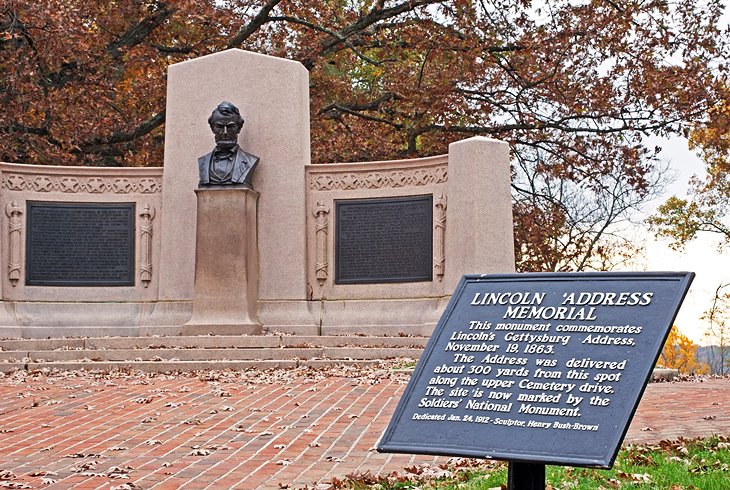
Less than six months after the Battle of Gettysburg, the Soldiers' National Cemetery was dedicated to honor the more than 3,500 Union soldiers who fought and perished here. President Abraham Lincoln was asked to give a few remarks at the ceremonies on November 19, 1863 and delivered his famous Gettysburg Address, one of the shortest and most memorable speeches in history.
The first monument was erected in 1869, honoring the 1st Minnesota Infantry, which suffered staggering casualties here on July 2, 1863.
The cemetery, designed by landscape architect William Saunders, forms a wide semicircle, its sections divided by state. It is on Cemetery Hill, the Union battle line, and includes a large part of the battlefield. It was one of the first national cemeteries and includes the graves of the fallen in later wars, as well.
Little Round Top
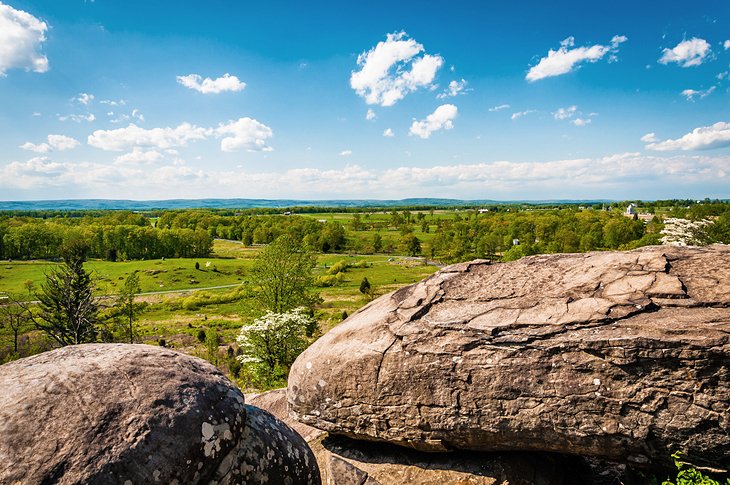
The rocky hill known as Little Round Top was the scene of what is considered to be the most decisive encounter of the Battle of Gettysburg. One of the best vantage points of the battlefields, Little Round Top is also one of the most evocative, as you can not only get an overview of the scene, but experience the rough, rock-strewn terrain these men fought in.
On the second day of the battle, Confederate troops launched an assault against the Union left flank, which was repulsed in a bayonet charge by men of the 20th Maine Regiment. That charge saved General Meade's Army of the Potomac, winning the Battle of Gettysburg and turning the tide of the entire war. The boulders of the adjacent rock-strewn area, known as Devil's Den, was a position for sharpshooters.
Editor's Note: The area around Little Round Top will be closed for extensive safety and accessibility renovations, as well as improved educational signage, with an expected re-opening during the 2024 summer season.
See the Gettysburg Civil War Reenactment
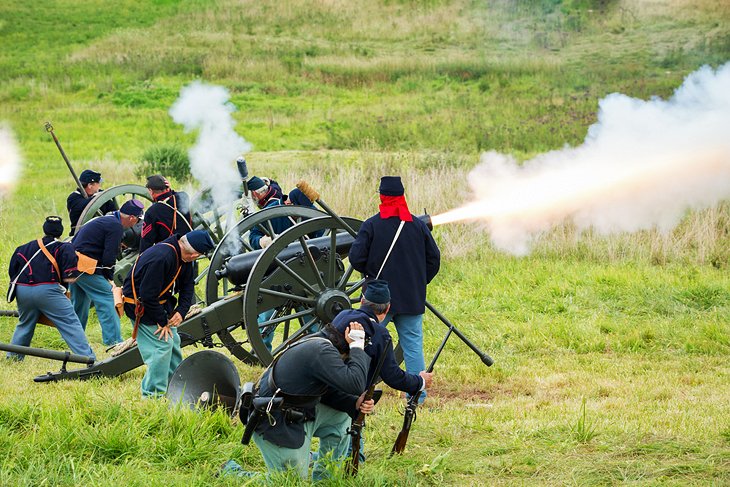
Each July, on the anniversary of the battle (July 1-3), history re-enactors in authentic Confederate and Union Army uniforms take on the roles of those who fought here, from generals to common foot soldiers of both armies, firing cannons and authentic weapons.
Historic lectures, demonstrations, replicas of military encampments, military band concerts, and displays of artifacts and period antiques are all part of the three-day commemoration of the battle, an event which has become a major annual tourist attraction in Gettysburg.
The park also puts on periodic living history events, which typically take place during September and October. During these demonstrations, you can walk through their encampments and interact with the historians as they re-enact various events and military regiments.
Address: 1195 Baltimore Pike, Gettysburg, Pennsylvania
Eisenhower National Historic Site

Not all the Gettysburg historical sites concern the famous battle. The home of President and Mrs. Dwight D. Eisenhower is the only one they ever owned, bought after his retirement in 1950, following a 30-year Army career.
The house at the Eisenhower National Historic Site is furnished as it was when Eisenhower used it in the 1950s as his weekend retreat and a place to entertain and meet informally with foreign dignitaries, who included Winston Churchill, Charles de Gaulle, and Nikita Khrushchev.
Among its decorations are Mamie's collections, White House artifacts, and gifts from foreign countries. A decorative arts tour, a collection of Eisenhower's paintings (he used to set his easel on the porch to paint), and a farm tour are special features here, along with a scavenger hunt for young visitors. A shuttle bus leaves from the National Park Visitor Center, where you can buy tickets.
The park is open year-round for self-guided tours of the grounds, and guided tours of the home are available during the summer tourist season.
Shriver House Museum

The restored 1860 home of the Shriver family takes you back to the tense days when Confederate sharpshooters commandeered their house and knocked two holes through its brick wall, so they could fire at Union troops on nearby Cemetery Hill.
Costumed interpreters at the Shriver House Museum bring to life the world of the Shriver children as you tour the authentically restored rooms, see the sharpshooters' "nest," and learn how modern investigative techniques were used to authenticate what happened here. During the restoration, medical supplies were found, confirming that it was also one of the houses used as a hospital for wounded soldiers.
If you're lucky enough to be in town between Thanksgiving and Christmas, be sure to book their special holiday tour. These candlelight tours let you get a glimpse of the family's wartime Christmas traditions, complete with a candle-filled tree and stockings.
Address: 309 Baltimore Street, Gettysburg, Pennsylvania
Jennie Wade House
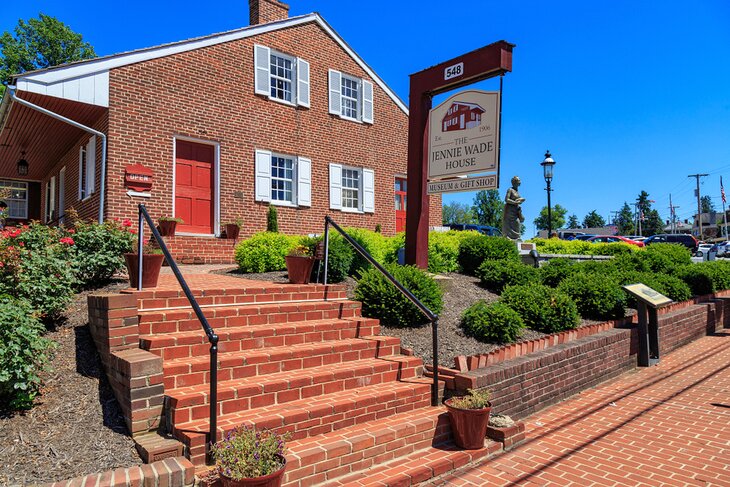
Despite the staggering losses to both armies in the battle that surrounded and filled the small town of Gettysburg for three days, only one civilian was killed. Twenty-year-old Jennie Wade was in her home, when a stray bullet went through two doors before hitting her as she kneaded bread in the kitchen.
The Jennie Wade House Museum looks much as it did when she lived here, and is authentically furnished throughout. Guides in period costumes discuss civilian and domestic life during the Civil War, and how it impacted Gettysburg. In front of the house is a statue of Jennie Wade.
Address: 548 Baltimore Street, Gettysburg, Pennsylvania
David Wills House
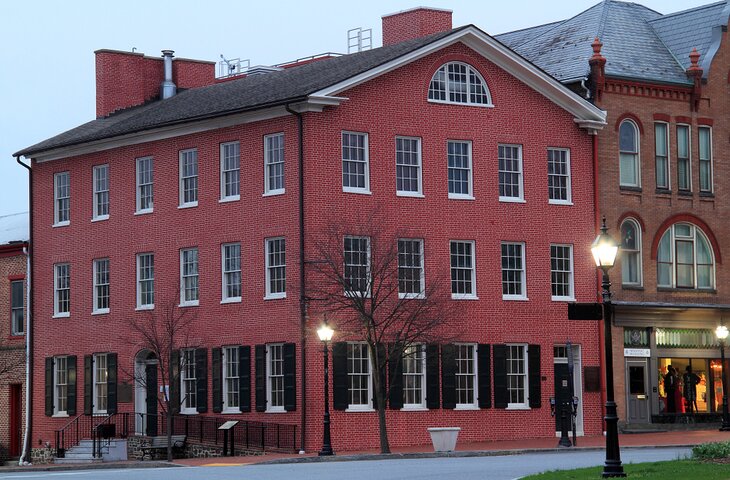
Following the battle, Gettysburg lawyer David Wills was active in local work to care for the wounded and bury the dead, and he led efforts to create a National Cemetery as a burial place for Union soldiers killed in battle or who died later of their wounds. It was at his downtown home that Lincoln stayed the night before delivering the Gettysburg Address, and where he prepared that famous speech.
The Wills House Museum illustrates life in Gettysburg after the battle and how local people were left with the tasks of cleanup and caring for the wounded. This house became a center for those efforts, and as you tour its rooms, you'll see exhibits on the Gettysburg Address and Wills' work in helping families looking for loved ones who were at the battle.
Wills' office and the bedroom where Lincoln stayed and worked on his speech are restored to their 1863 appearance. An eye-catching statue of Lincoln stands outside the house, gesturing to another life-sized statue of a modern-day tourist as though he were telling him about his stay there. You can take the Freedom Transit Shuttle here from the visitor center.
Address: 8 Lincoln Square, Gettysburg, Pennsylvania
Gettysburg Museum of History
The wide-ranging collections of military artifacts in the privately owned Gettysburg Museum of History began with bullets, shells, buckles, buttons, and other remnants of the Civil War found by the owner's family as they tilled their Gettysburg farm. The collections grew and expanded to include more artifacts from the Civil War, World War I, World War II, and American presidents, which now fill the museum.
Among the interesting items on display are dummy paratroopers that were dropped in Normandy as part of Operation Titanic, a deception plan to divert enemy attention from the D-Day landing sites. The museum is free, and there is a small shop where you can buy authenticated artifacts to begin your own collection.
Address: 219 Baltimore Street, Gettysburg, Pennsylvania
Sachs Covered Bridge
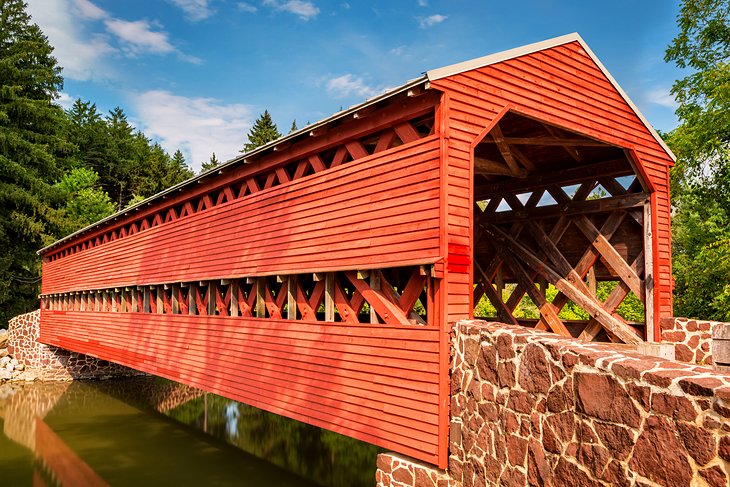
One of Gettysburg's most popular scenic sights is the red Sachs Bridge, a 100-foot-long covered bridge spanning Marsh Creek. During the Civil War, the bridge was used by both the Union and Confederate Armies and served as a major escape route for the Confederate army as it retreated to Virginia after the Battle of Gettysburg.
It is built in the style known as Town Truss and is on the National Register of Historic Places. It is open to pedestrians only.
Address: Waterworks Road, Gettysburg, Pennsylvania
Bicycling Through the Battlefield
Bicycles and e-bikes are welcome in the battlefields and are a good way to tour, although you must either walk them or leave them in provided racks while touring the cemeteries. The roads are shared with automobile traffic, and no off-road bicycling is allowed.
Map of Attractions & Things to Do in Gettysburg
More Related Articles on PlanetWare.com
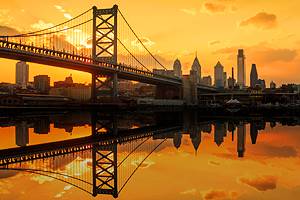
Where to Go near Gettysburg: Along with those in historic Philadelphia, there are a lot of tourist attractions in Pennsylvania. For even more suggestions, check out our page on the Weekend Getaways in Pennsylvania.
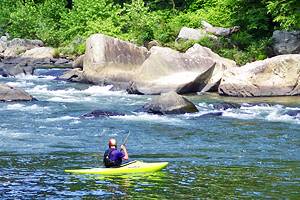
Exploring the Great Outdoors: You'll find abundant national and state parks in Pennsylvania, and hikers should refer to our list of the best hiking trails in Pennsylvania. If water-related sports are more your style, see our pages on fly fishing regions and white water rafting and kayaking destinations in Pennsylvania.


